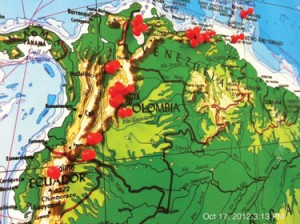Oil booms. There was one in the 1950s and another in the late 1970s. People flocked to the towns in West Texas and southeast New Mexico. Companies were started and large ones expanded. Schools, housing, shopping all grew. People worked hard, played hard, and spent a lot of money.
These were followed by that eventuality: “What goes up must come down.” And the busts hit. Hard. People left. Offices closed doors and some of the major oil companies that had offices in Midland for many years moved away in the 1980s. Other companies were gobbled up by larger ones. Drilling rigs and equipment sat untouched in yards, developing rust in the passing years.
But, exploration, production, and technology advances never stopped.
By the mid-2000s, the Permian Basin began to rumble to life again. Today, the area is experiencing another boom. Companies that had started on a small basis are growing into large independents. Corporations are  expanding operations here or coming back in some form.
expanding operations here or coming back in some form.
“For one single basin, the Permian Basin probably has more oil than any other in the country,” noted W. Hoxie Smith, director of the Midland College Petroleum Professional Development Center. This continuing education arm of MC stays busy offering classes for companies’ new hires and updating other careerists about advances in technology.
The Texas Railroad Commission website notes that since 1921, almost 29 billion barrels of oil have been pulled out of the Permian Basin.
In August 2012, Reuters news service reported that BENTEK Energy, an energy market analytics company, predicted crude oil production in the Permian Basin will rise by 60 percent to reach at least 1.82 million barrels per day by the end of 2016. “The Permian’s oil output has grown consistently since May 2011, some of which is from shale oil prospects, and the Basin will host [attract] more oil drillers in the next five years, the Colorado-based consultancy said. BENTEK estimates current Permian oil production is at 1.29 million bpd.”
Hydraulic fracturing. Horizontal drilling. CO2 recovery. Waterflooding. These techniques have opened the floodgates to oil and gas drilling in the Basin. The bright future predicted for the Basin is calling people back to the area.
When corporations were fleeing the Basin in the 1980s, Chevron stayed and today celebrates 85 years in West Texas and southeast New Mexico. It is expanding its holdings and planning to construct a new office complex in Midland.
“We were the largest acreage holder in the Permian Basin” prior to the September purchase of 246,000 acres in the Delaware Basin from Chesapeake,” said Mike Rieken, Chevron oil area manager based in Midland. This acreage in the Delaware Basin will be added to the 700,000 acres Chevron already owns in the region. “Since our acquisition, we have solidified our position in the Permian Basin. This is a well-established hydrocarbon  base. It is predominantly liquids as opposed to tight shale gas. This is what we like to see.”
base. It is predominantly liquids as opposed to tight shale gas. This is what we like to see.”
A news release from Chevron about the purchase shared this observation from Gary Luquette, president of Chevron North America Exploration and Production Company: “This investment gives us significant exposure to stacked Delaware Basin plays where we already enjoy a substantial position. It complements our existing Permian Basin operations and provides us access to additional people and resources to execute our growth strategy there.”
“The Wolfcamp and the Delaware Basin are very large areas. The drilling and completion risks are smaller. You can drill uneconomic wells in both basins and the challenge is to find where the sweet spots are,” Rieken said.
When Rieken attended Texas Tech University in the late 1970s, he studied all the various fields along with a process called waterflooding. Then came the bust of the early 1980s and the young engineer was assigned to other areas. “That was the most memorable bust. I remember waiting daily to see if I had a job. But each time there’s a bust, the Permian Basin seems to re-invent itself.”
Several years ago, according to Rieken, “all the majors were pulling out of the Basin. It was considered a declining asset. Well, it’s re-invented itself again. This must be its third re-invention.”
Chevron, according to Rieken, is the No. 2 oil producer in the Permian Basin, No. 3 in the United States, and No. 1 in upstream earnings.
“Shale plays,” he noted, “are not wildly economic, not like a deep water well. You drill a lot of them, so it’s price sensitive. Again, the resource is there and we know how to get to it. We’ll drill about 200 wells this year in the Permian Basin. We have six wells in the Delaware Basin with plans to drill another 16. So, we’re just starting in the Delaware.”
With its plans for an expanded drilling program, Chevron was realistic enough to recognize that office space was getting squeezed. The company employees about 1,000 people in the Permian Basin. Of that number, about 450 work at the Midland ClayDesta office, while the rest work in field offices around the Basin. In May 2012, Chevron announced plans to spend more than $100 million to design and build a new campus on 25 acres on the far west side of Midland. Rieken noted his company is planning to hire more employees and is ramping up recruitment at several universities, including Texas Tech and University of Texas of the Permian Basin.
And what if another bust comes? “There’s no reason to expect the price of oil to go up and down like it did before. These are additional resource plays that will take decades to develop,” Rieken added.
Chevron bought just the northern section of Chesapeake’s leases. Taking assets in the southern part of the Delaware Basin is Royal Dutch Shell, which will bring Shell back into the Permian Basin for the first time in many years. The company plans to spend about $1.94 billion for 618,000 acres in West Texas with current production of 26,000 barrels of oil equivalent a day. Plans have not been announced for a Midland office.
The MarketWatch section of the Wall Street Journal reported in September 2012 that Shell’s purchase “will mark its first big acquisition in the Permian.” A Shell spokesman told MarketWatch, “The acquisition provides both existing production and near-term growth potential from a proven resource, as well as promising opportunities for expansion.”
This may not be the last time a major oil company finds an easy way to expand its Basin’s holding or to mount a return to the region. In that same installment of MarketWatch, Lysle Brinker, director of research for IHS, said major oil companies have been moving back into the U.S. after pulling up stakes abroad in the 1990s. “The independent energy companies are the ones that started the unconventional revolution and the big guys were late to the game, but now that it’s a viable business, they’re trying to take advantage of opportunities. They have a lot of cash.”
That apparently was the situation with Exxon Mobil when it purchased XTO Energy Inc. for $30 billion in December 2009 in a move to add to its shale gas assets to take advantage of low natural gas prices.
The situation marked a role reversal from some four years previous, when, in 2005, XTO purchased Exxon Mobil Corp.’s Permian properties in West Texas and New Mexico for $215 million. At that time, XTO Chief Executive Bob Simpson told Wall Street Journal’s MarketWatch, “This transaction highlights our ongoing focus in acquiring specific properties in regions where XTO has experience and a history of increasing production and reserves.”
Exxon Mobil will not comment on any plans to add a Midland office or personnel.
Another company that stayed in the Permian Basin was Oxy, USA. While other majors were leaving during the 1990s, Oxy stayed and developed its CO2 technology. Its website calls the firm “the No. 1 producer of crude oil in the Permian with a 15 percent net share of the Basin’s total production. Our net interest of 3 million oil and gas acres with more than 2,000 drilling locations as of year-end 2011 provide us with opportunity for future growth. In our non-CO2 operations, we are seeing additional opportunity for good return projects. These include extensive Wolfberry drilling programs as well as Delaware Bone Spring Sands and multiple shale plays. As a result, we have stepped up our capital and 2012 will be about 75 percent higher than 2011 levels.
“Oxy’s Permian operations showcase our expertise in employing advanced technologies to extend production from established fields. About two-thirds of our Permian oil production is from fields that employ CO2 or carbon dioxide flood technology.”
ConocoPhillips also never left the Basin and maintains offices in Midland and Odessa. According to the firm’s website, “In the Permian Basin in West Texas, ConocoPhillips is optimizing production from its 1.1 million net acre position, with plans to increase drilling activity in 2012. With resources of approximately 1 billion BOE, the basin is expected to remain a profitable, liquids-rich producing asset for years to come.”
There was no information on the website about any office or personnel expansion in the Midland area.
Hoxie Smith, who worked for ARCO Oil & Gas during the earlier boom, summarized today’s economic situation: “This is the best of times for Midland.”










